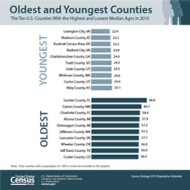For Immediate Release: Thursday, June 23, 2016
Sumter County, Fla., is Nation's Oldest, Census Bureau Reports
Only County in Nation With Majority of Population Age 65 or Older
JUNE 23, 2016 -- The nation's only county with a majority of the population age 65 or older remains Sumter, Fla., where 54.8 percent had reached retirement age in 2015, up from 53.0 percent in 2014. Part of the nation's fastest growing metro area (The Villages), Sumter County had a median age of 66.6 years on July 1, 2015, according to new U.S. Census Bureau population estimates released today.
The new detailed estimates by age, sex, race and Hispanic origin show the nation's 65-and-older population grew from 46.2 million in 2014 to 47.8 million in 2015. This group continues to show rapid percentage growth, even as baby boomers and previous generation groups that make up this age group decline in population.
"Sumter County is unique as the only county with a majority age 65-and-older population," said Jason Devine, assistant division chief for Population Estimates and Projections, "As the nation's 65-and-over population grows, other counties with retirement communities like The Villages will get closer to this threshold."
Among counties with a population of 1,000 or more, only two nationwide had a median age of 60 or older. In addition to Sumter County, the other was Catron, N.M. (60.1 years). In all, there were 160 counties that had a median age of 50 or older. Rounding out the top five oldest were Charlotte, Fla. (58.4 years); Alcona, Mich. (57.9 years); and Ontonagon, Mich. (57.3 years), tied with Jefferson, Wash. (57.3 years). At the other end of the spectrum, 66 counties had a median age of 30 or less, with Lexington, Va. (22.4 years) being the youngest, followed by Madison, Idaho (23.2 years), and Kusilvak Census Area, Alaska (23.3 years).
Nationwide, America's youngest generation, or those born since 2000, saw its population rise 7.3 percent between July 1, 2014, and July 1, 2015, to 61.0 million.
This group was the most diverse generation. Nearly half (49.0 percent) belong to a race or ethnic minority group other than non-Hispanic, white alone. In contrast, 44.5 percent of our nation's 83.7 million millennials ─ those born between 1982 and 2000 ─ were of a group other than non-Hispanic, white alone.
These latest population estimates examine changes among groups by age, sex, race and Hispanic origin at the nation, state and county levels, between April 1, 2010, and July 1, 2015. In addition, estimates for Puerto Rico and its municipios are available by age and sex.
Other highlights from the estimates:
Age and Sex
- In 2015, 24-year-olds had the largest population out of any single year of age at 4.7 million.
- North Dakota was the only state that saw its median age decline from 34.9 to 34.6 between July 1, 2014, and July 1, 2015.
- There was about a 14-year age difference between the state with the highest median age in 2015 (Maine at 44.5 years) and the state with the lowest (Utah at 30.7 years).
- Kenedy County, Texas, had the largest increase in median age between 2014 and 2015 (3.3 years).
- Ten states were majority male in 2015, led by Alaska at 52.7 percent.
The 65-and-Older Population
- Florida had the highest percentage of its population age 65 and over among states in 2015 (19.4 percent), followed by Maine (18.8 percent) and West Virginia (18.2 percent). Alaska had the lowest percentage (9.9 percent), followed by Utah (10.3 percent).
The Hispanic Population
- The nation's Hispanic population totaled 56.6 million as of July 1, 2015, up by 1.2 million, or 2.2 percent, since July 1, 2014. Their growth is due largely to natural increase.
- California had the largest Hispanic population of any state (15.2 million) in 2015. Texas had the largest numeric increase within the Hispanic population since July 1, 2014 (250,495). New Mexico had the highest percentage of Hispanics at 48.0 percent.
- Los Angeles County, Calif., had the largest Hispanic population of any county (4.9 million) in 2015, while Harris County, Texas, had the largest numerical increase since 2014 (49,000). Starr County ─ on the Mexican border in Texas ─ had the highest share of Hispanics (95.8 percent).
The White Population
- The nation's white alone or in combination population totaled more than 255 million in 2015, up 0.5 percent since 2014.
- California had the largest white alone or in combination population of any state on July 1, 2015 (29.8 million). Texas had the largest numeric increase of the white alone or in combination population (330,064). Vermont had the highest percentage of its population as white alone or in combination (96.6 percent).
- Los Angeles County, Calif., had the largest white alone or in combination population in 2015 (7.5 million). Maricopa County, Ariz., had the highest numeric increase since 2014 (55,700). Blaine County, Neb., led the nation in the percentage of population that was white alone or in combination in 2015 (over 99.0 percent).
The Black or African-American Population
- The nation's black or African American population totaled 46.3 million as of July 1, 2015, up 602,000, or 1.3 percent, since July 1, 2014. Their growth is due largely to natural increase.
- New York had the largest black population of any state or equivalent in 2015 (3.8 million). Texas had the largest numeric increase since July 1, 2014 (94,000). The District of Columbia had the highest percentage of blacks (50.0 percent), followed by Mississippi (38.3 percent).
- Cook County, Ill. (Chicago) had the largest black population of any county in 2015 (1.3 million). Harris County, Texas, had the largest numeric increase since 2014 (22,200). Claiborne County, Miss., was the county with the highest percentage of black or African Americans in the nation (85.1 percent).
The Asian Population
- The nation's Asian population totaled 21.0 million as of July 1, 2015, up 683,000, or 3.4 percent, since July 1, 2014. Their growth is due largely to net migration.
- Asians were the fastest growing race group.
- California had both the largest Asian population of any state (6.5 million) in July 2015, as well as the largest numeric increase (169,900). Hawaii was the nation's only majority Asian state (56.0 percent).
- Los Angeles County, Calif., had the largest Asian population of any county (1.7 million) in 2015 and the largest numeric increase (30,200) since 2014. Honolulu County and Kauai County, both in Hawaii, were the nation's only majority Asian counties.
Two or More Races
- Those who identify as two or more races had a total population of 8.2 million, up 3.1 percent from 2014. This was the second-fastest growing race group in the nation. Their growth is primarily due to natural increase.
- This group had the youngest median age of any other race group at 20.0 years.
The American Indian and Alaska Native Population
- The nation's American Indian and Alaska Native population totaled 6.6 million as of July 1, 2015, up 95,000, or 1.5 percent, since July 1, 2014. Their growth is due largely to natural increase.
- California had the largest American Indian and Alaska Native population of any state in 2015 (1.1 million), while Texas had the largest numeric increase since July 1, 2014 (12,300). Alaska had the highest percentage of American Indian and Alaska Natives (19.5 percent).
- Los Angeles County, Calif., had the largest American Indian and Alaska Native population of any county in 2015 (235,000) and Maricopa County, Ariz., the largest numeric increase since 2014 (4,400). There were 29 counties nationwide that were majority American Indian and Alaska Native, led by Kusilvak Census Area, Alaska, at 93.4 percent.
The Native Hawaiian and Other Pacific Islander Population
- The nation's Native Hawaiian and Other Pacific Islander population totaled 1.5 million as of July 1, 2015, up 35,000, or 2.4 percent, since July 1, 2014. Their growth is due largely to natural increase.
- Hawaii had the largest numeric population of Native Hawaiians and Other Pacific Islanders of any state in 2015 (373,000), as well as the highest percentage (26.0 percent). California had the largest numeric increase since 2014 (6,300).
- Honolulu County, Hawaii, had the largest population of Native Hawaiians and Other Pacific Islanders of any county (240,400) in 2015, while Clark County, Nev., had the largest numeric increase since 2014 (1,300). Kalawao County, Hawaii, was the nation's only county where more than half of the population was in this group in 2015 (52.8 percent).
The Non-Hispanic White Alone Population
- The nation's non-Hispanic, white alone population totaled 198.0 million in 2015, up by 126,000, or 0.1 percent since 2014.
- California had the largest non-Hispanic, white alone population of any state on July 1, 2015 (14.9 million). Florida had the largest numeric increase of the non-Hispanic white alone population since July 1, 2014 (112,000). Maine had the highest percentage of its population as non-Hispanic, white alone (93.6 percent).
- Los Angeles County, Calif., had the largest non-Hispanic, white alone population in 2015 (2.7 million). Maricopa County, Ariz., had the highest numeric increase in the non-Hispanic, white alone population since 2014 (23,600). Blaine County, Neb., led the nation in the percentage of population that was non-Hispanic, white alone in 2015 (over 98.0 percent).
Unless otherwise specified, the statistics refer to the population who reported a race alone or in combination with one or more races. Censuses and surveys permit respondents to select more than one race; consequently, people may be one race or a combination of races. The detailed tables show statistics for the resident population by "race alone" and "race alone or in combination." The sum of the populations for the five "race alone or in combination" groups adds to more than the total population because individuals may report more than one race. The federal government treats Hispanic origin and race as separate and distinct concepts. In surveys and censuses, separate questions are asked on Hispanic origin and race. The question on Hispanic origin asks respondents if they are of Hispanic, Latino or Spanish origin.
Starting with the 2000 Census, the question on race asked respondents to report the race or races they consider themselves to be. Hispanics may be of any race. Responses of "some other race" from the 2010 Census are modified in these estimates. This results in differences between the population for specific race categories for the modified 2010 Census population versus those in the 2010 Census data.
-X-









